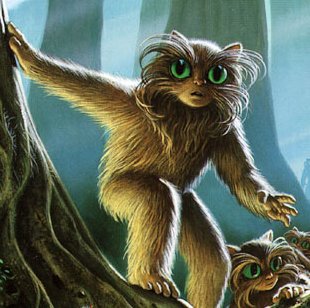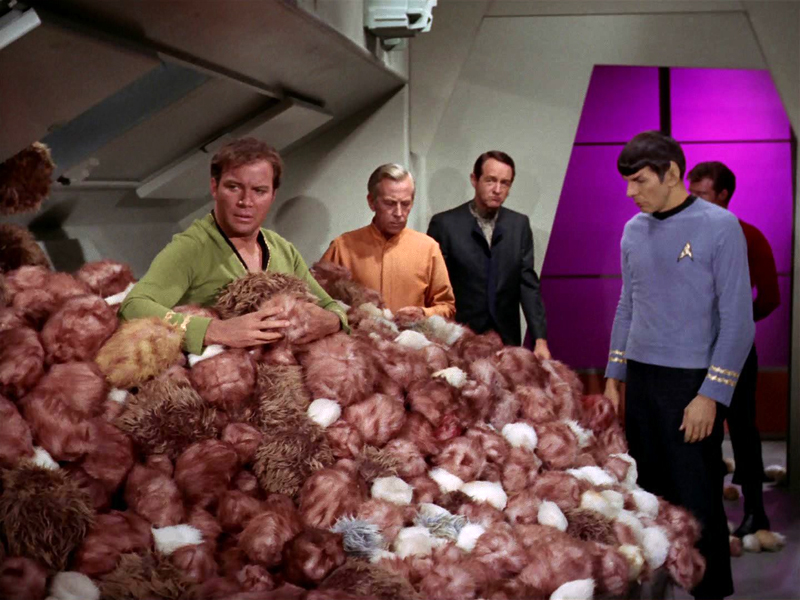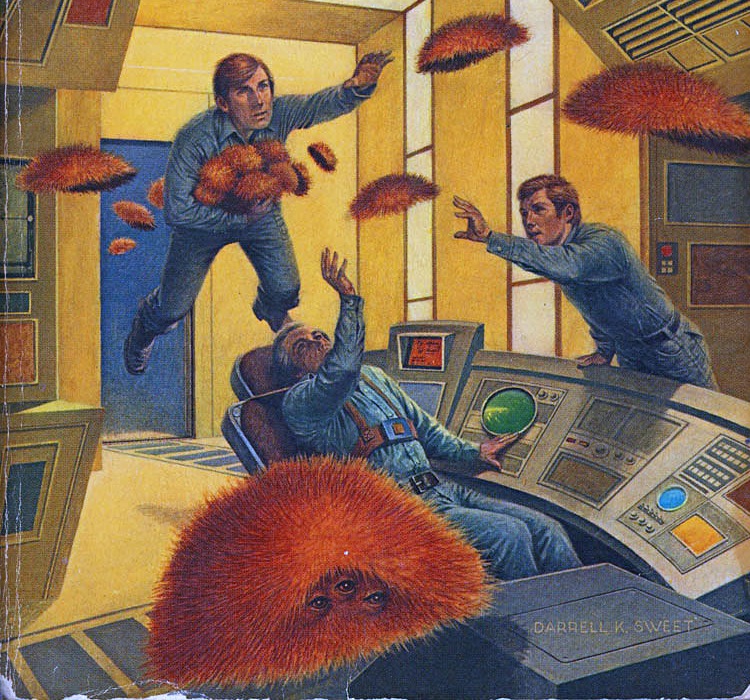Cuteness in Science Fiction
I recently reread Little Fuzzy by H. Beam Piper and realized it’s success was probably due to cuteness. Cuteness is hard to define but generally deals with little creatures like kittens, puppies, babies, and toddlers. In the case of science fiction, cuteness comes in the form of little aliens or small robots.

Little Fuzzy was a read for my science fiction book club and most of the members enjoyed a story about cute critters being discovered by a gem miner on a distant planet. Piper’s plot examined what makes a being sentient, which is a serious, non-cute subject. However, because of the enduring popularity of fuzzy stories, we could also say Piper explored the concept of cuteness in science fiction. If you want to know more about the series read “The Fuzzy Story.”
I always pictured fuzzies sort of like Gizmo from Gremlins. Big eyes, small, furry – all the elements of cuteness. Big eyes seem to be a major element of anime. And, furry leads to furry fandom. I wonder if furries were inspired by Piper’s fuzzies? I’m not a fan of anime or furry so I’m not sure how they emerged, but I have to assume some form of cuteness was at the heart of their inspiration. Science fiction has always appealed to the young, and young at heart, so such subgenres of cute F&SF have their fans. I’m not one, but I do see cuteness as a hook for writers.
John Scalzi wrote a remake called Fuzzy Nation that has sales-appeal because of the cuteness of fuzzies.
 Science fiction is seldom about cute – but when science fiction does get cute, those stories are often fondly remembered. Just think of “Trouble with Tribbles,” David Gerrold’s classic Star Trek episode. Of course, I thought Tribbles were a rip off of Flat Cats from The Rolling Stones by Robert A. Heinlein, which had its cuteness appeal. And I have to assume the idea of cute critters that multiply quickly wasn’t original with Heinlein. One of the flat cats was named Fuzzy Britches. So fuzzies might have also come from flat cats.
Science fiction is seldom about cute – but when science fiction does get cute, those stories are often fondly remembered. Just think of “Trouble with Tribbles,” David Gerrold’s classic Star Trek episode. Of course, I thought Tribbles were a rip off of Flat Cats from The Rolling Stones by Robert A. Heinlein, which had its cuteness appeal. And I have to assume the idea of cute critters that multiply quickly wasn’t original with Heinlein. One of the flat cats was named Fuzzy Britches. So fuzzies might have also come from flat cats.
Cuteness is often linked to humor, like a cousin to comic relief. If the fuzzies hadn’t been cute, would Piper’s story had been as successful? Some stories can be improved with a dash of cuteness, but too much can be cloying. Most of the humor in “Trouble With Tribbles” seems strained today. It was saved by the cuteness of tribbles. I tend to think the cute fuzzies saved Piper’s story. It was reasonably well written for its time and market but it wasn’t that original. Piper was a solid genre writer back then, but isn’t well remembered today, except for creating fuzzies.
Pixar and Disney depend on a certain amount of cuteness to drive their genre and non-genre films. If there’s too much cuteness their stories will only appeal to children. Blockbuster animated films depend on attracting audiences of all ages.
 My first encounter with cuteness in science fiction came from Willis, the Martian “bouncer” in Heinlein’s Red Planet. Willis was fuzzy and round like a medicine ball. Willis could protrude eye stalks or other appendages. He whistled. Which reminds me of R2D2. That’s another area of cuteness in science fiction, small robots like R2D2, WALL-E, and the little robots in Silent Running, Huey, Dewey, and Louie (for those people who remember really old science fiction).
My first encounter with cuteness in science fiction came from Willis, the Martian “bouncer” in Heinlein’s Red Planet. Willis was fuzzy and round like a medicine ball. Willis could protrude eye stalks or other appendages. He whistled. Which reminds me of R2D2. That’s another area of cuteness in science fiction, small robots like R2D2, WALL-E, and the little robots in Silent Running, Huey, Dewey, and Louie (for those people who remember really old science fiction).
So cute isn’t always fuzzy, it can be metallic, if small. The Heinlein juveniles had a number of strange alien creatures, but most of them were not cute. Often, cuteness in science fiction is repackaged puppies and kittens, reshaped, with a bit of mischievous intelligence. Hardly original, but it does tap into our fondness for cuteness.
 One of the ironic aspects of Little Fuzzy was the main characters wanted to prove fuzzies were sentient, yet they also wanted to own them, treating them like pets. In some science fiction stories, humans have been pets to advanced aliens and we think that evil. Why is it okay when we do it?
One of the ironic aspects of Little Fuzzy was the main characters wanted to prove fuzzies were sentient, yet they also wanted to own them, treating them like pets. In some science fiction stories, humans have been pets to advanced aliens and we think that evil. Why is it okay when we do it?
Cute brings out our maternal and paternal instincts, which is a driving force in the pet industry. However, we’ve cruelly enslaved many species that aren’t suited to domestication. I haven’t read the sequels to Little Fuzzy, but I have to wonder if Piper explored fuzzy exploitation. Cuteness isn’t a great trait for many animals because we’ll cage them for our idle moments when we feel the need to be amused by something small and cute. We also tend to want our kids not to grow up and leave their cute stage, which is unfair. And doesn’t anime and furry fandom encourage arrested development?
We might not see a lot of cuteness in science fiction because it’s something we should limit. Our reality isn’t cute. Maybe I’m an old curmudgeon because I thought the best parts of Little Fuzzy were its serious aspects, and the cute aspects were misguided. Shouldn’t the humans have left the fuzzies alone, and just observed them? Shouldn’t the Prime Directive apply to cute critters too?



















 Full Details
Full Details


3 Comments
I have not followed fuzzzies, and didn’t care for Gremlins flicks, but I am curious which SciFi stories that you read contain aliens that have humans as pets?
Brian, I can’t quickly remember any famous print story examples, except there was a story by Ray Bradbury I think where humans were in an alien zoo. But on The Twilight Zone, Outer Limits, and many episodes of the original Star Trek there were stories where humans were the playthings of aliens. I wish my memory was better. There was a William Tenn story where humans lived like rats in the walls in a world of giant aliens. Maybe someone else can remember some specifics.
The main character in Slaughter House 5 is kept in an alien zoo. There is also a book where humans are used as mounts (instead of horses). Can’t remember the name of the book or the author though.
Sorry, the comment form is closed at this time.